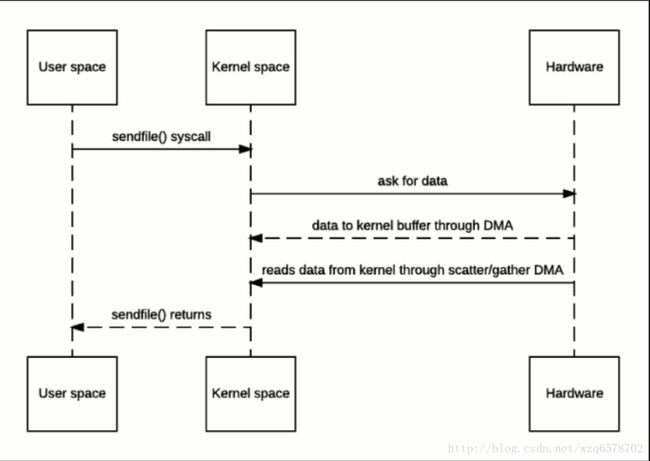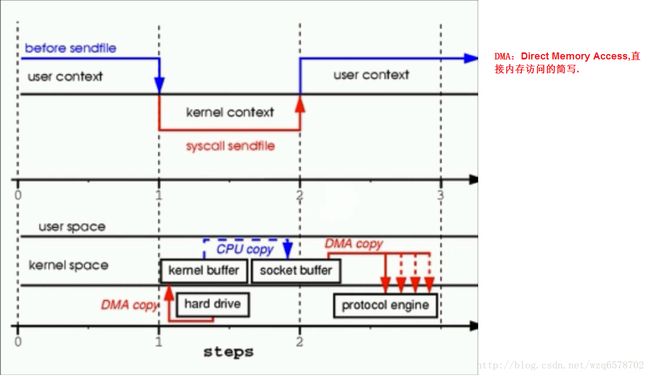netty源码分析(二十)NIO堆外内存与零拷贝深入讲解
ByteBuffer byteBuffer = ByteBuffer.allocateDirect(512);
直接内存:返回DirectByteBuffer对象,DirectByteBuffer的父类是MappedByteBuffer ,MappedByteBuffer 的父类是ByteBuffer , 在ByteBuffer的上边是Buffer,在
Buffer里边有一个address 他的声明和注释如下:
// Used only by direct buffers
// NOTE: hoisted here for speed in JNI GetDirectBufferAddress
long address;
address是专门为DirectByteBuffer使用的,存储是堆外内存的地址。在 DirectByteBuffer 的构造器里边,会对 address 进行赋值。
DirectByteBuffer使用的是直接的对外内存,去除了使用HeapByteBuffer方式的内存拷贝,因此有另外一个说法叫“零拷贝”,address对应的内存区域在os的内存空间,这块内存直接与io设备进行交互,当jvm对DirectByteBuffer内存垃圾回收的时候,会通过address调os,os将address对应的区域回收。
ByteBuffer byteBuffer = ByteBuffer.allocate(512);
堆内存:返回 HeapByteBuffer
HeapByteBuffer是在jvm的内存范围之内,然后在调io的操作时会将数据区域拷贝一份到os的内存区域,这样造成了不必要的性能上的降低,这样做是有原因的,试想假设如果os和jvm都是用jvm里边的数据区域, 但是jvm会对这块内存区域进行GC回收,可能会对这块内存的数据进行更改,根据我们的假设,由于这块区域os也在使用,jvm对这块共享数据发生了变更,os那边就会出现数据错乱的情况。那么如果不让jvm对这块共享区域进行GC是不是可以避免这个问题呢?答案是不行的,也会存在问题,如果jvm不对其进行GC回收,jvm这边可能会出现OOM的内存溢出。因此,最后这个地方非常尴尬,只能拷贝jvm的那一份到os的内存空间,即使jvm那边的数据区域被改变,但是os里边的不会受到影响,等os使用io结束后会对这块区域进行回收,因为这是os的管理范围之内。
如果你想了解更详细的说明请看知乎的一个回答:https://www.zhihu.com/question/57374068
RednaxelaFX是一个大牛,在社区中参与到jvm的很多工作。
再说一下NIO的零拷贝,如图:
case1非零拷贝(传统的方式):
传统方式的NIO存在数据拷贝问题,实例代码:
客户端:
public class OldClient {
public static void main(String[] args) throws Exception {
Socket socket = new Socket("localhost",8899);
InputStream inputStream = new FileInputStream("niofiles/spark-2.2.0-bin-hadoop2.7.tgz");
DataOutputStream dataOutputStream = new DataOutputStream(socket.getOutputStream());
int totalSend = 0;
int readCount = 0;
byte[] buff =new byte[4096];
long startTime = System.currentTimeMillis();
while((readCount=inputStream.read(buff))>=0){
totalSend+=readCount;
dataOutputStream.write(buff);
}
System.out.println("send bytes :"+totalSend+",timecost:"+(System.currentTimeMillis()-startTime));
dataOutputStream.close();
socket.close();
inputStream.close();
}
}服务端代码:
public class OldServer {
public static void main(String[] args) throws Exception{
ServerSocket serverSocket = new ServerSocket(8899);
while(true){
Socket socket = serverSocket.accept();
DataInputStream dataInputStream = new DataInputStream(socket.getInputStream());
byte[] buff = new byte[4096];
while(true){
int readcount = dataInputStream.read(buff,0,buff.length);
if(-1==readcount){
break;
}
}
}
}
}图示:

注意第一次数据拷贝是必须的。
case2零拷贝:
新的IO即NIO是零拷贝的方式:
实例代码:
客户端
public class NewClient {
public static void main(String[] args) throws Exception{
SocketChannel socketChannel = SocketChannel.open();
socketChannel.connect(new InetSocketAddress("localhost",8899));
socketChannel.configureBlocking(true);
String name = "niofiles/spark-2.2.0-bin-hadoop2.7.tgz";
FileChannel fileChannel = new FileInputStream(name).getChannel();
long start = System.currentTimeMillis();
//零拷贝关键代码
/**
* This method is potentially much more efficient than a simple loop
* that reads from this channel and writes to the target channel. Many
* operating systems can transfer bytes directly from the filesystem cache
* to the target channel without actually copying them.
*/
long transCount = fileChannel.transferTo(0,fileChannel.size(),socketChannel);
System.out.println("发送字节数:"+transCount+",耗时:"+(System.currentTimeMillis()-start));
fileChannel.close();
}
}服务端:
public class NewServer {
public static void main(String[] args) throws Exception {
ServerSocketChannel serverSocketChannel = ServerSocketChannel.open();
ServerSocket serverSocket = serverSocketChannel.socket();
serverSocket.bind(new InetSocketAddress(8899));
serverSocket.setReuseAddress(true);
ByteBuffer byteBuffer = ByteBuffer.allocate(4096);
while(true){
try {
SocketChannel socketChannel = serverSocketChannel.accept();
socketChannel.configureBlocking(true);
int readcount = 0;
while(-1!=readcount){
readcount = socketChannel.read(byteBuffer);
byteBuffer.rewind();
}
} catch (IOException e) {
e.printStackTrace();
}
}
}
}图示:

数据首先通过DMA从硬件设备(硬盘)读取到内核空间,然后将内核空间数据copy对接到socket buffer,socket buffer是一个缓冲区,之后socket buffer数据拷贝到协议引擎写到服务器端。这里减去了传统io在内核和用户之间的拷贝,但是内核里边的拷贝还是存在。
到时到了Linux2.4又有了改善:

再看最后一个图,Linux2.4以后的版本:

socket buffer 在这里不是一个缓冲区了,而是一个文件描述符,描述的是数据在kernel buffer的数据从哪里开始,长度是多少,里边基本上不存储数据大部分是指针,然后协议引擎protocol engine也是通过DMA 拷贝的方式从文件描述符socket buffer读取。
首先首先从硬件设备读取数据到kernel buffer,kernel buffer可能是多个字节数组,然后socket buffer 通过gatter的方式直接从kernel buffer映射(从哪个位置,读取多少长度,即gatter操作)数据,最后协议引擎protocol engine通过socket buffer的映射读到kernel buffer数据,再也没有数据拷贝的问题。
